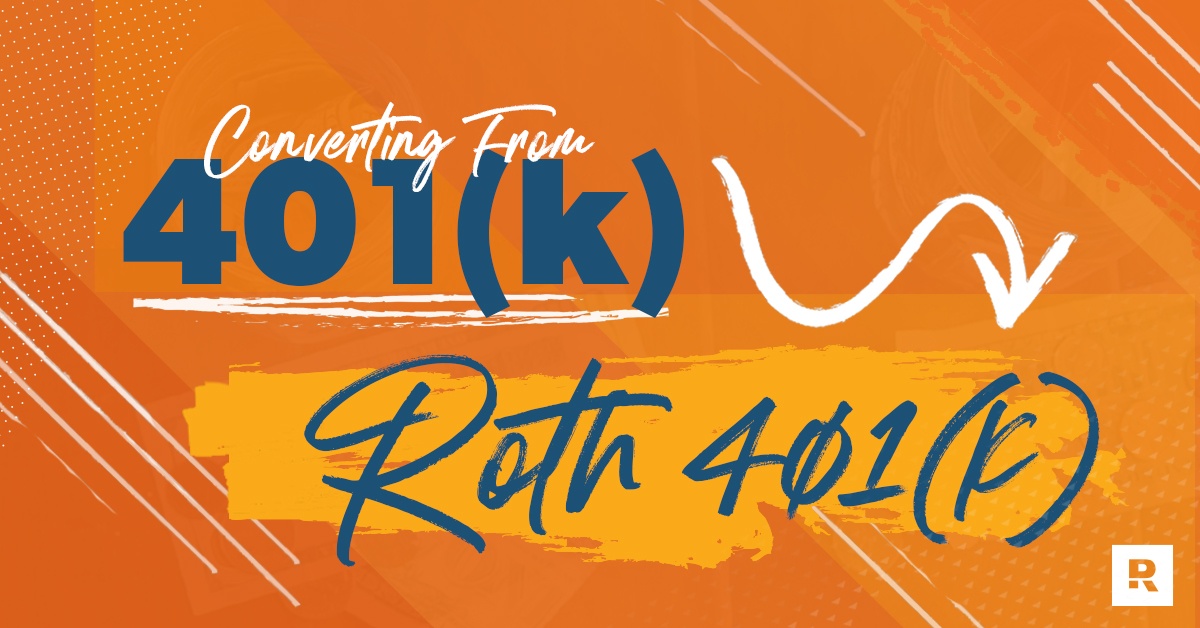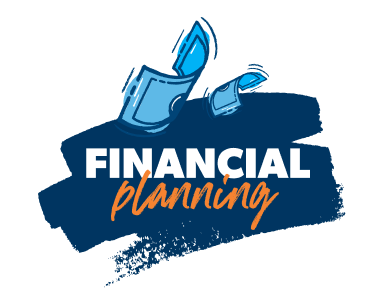Should You Convert Your Traditional 401(k) Into a Roth 401(k)?
9 Min Read | Feb 27, 2025

Key Takeaways
- Converting your traditional 401(k) to a Roth 401(k) means you pay taxes now so your money can grow tax-free. Then, you won’t owe taxes when you withdraw in retirement.
- But keep in mind, a Roth conversion means you have to pay taxes on all the money you want to convert, and that can lead to a huge tax bill depending on how much you decide to transfer from your traditional 401(k) and what tax bracket you’re in.
- You should only convert your traditional 401(k) to a Roth 401(k) once you’re completely debt-free and you can pay for the tax bill right now with cash on hand.
- If you can’t pay the tax bill for a Roth conversion right now, that’s okay! You can keep the money in your old 401(k) or roll it into an IRA and start putting money into a new Roth 401(k).
to company-sponsored retirement accounts. Today, about 93% of employers offer a Roth 401(k) options to their employees.1 If the Roth 401(k) is on the table at your workplace, that’s great news for you!
Get expert money advice to reach your money goals faster!
But if your company does, in fact, offer a Roth 401(k) option, you might be wondering what to do with your existing traditional 401(k). Is converting a traditional 401(k) to a Roth the way to go? Or should you just leave it alone? There are some things to keep in mind before you make this decision, so let’s dive in.
Traditional 401(k) vs. Roth 401(k): What’s the Difference?
Traditional 401(k)s and Roth 401(k)s are both workplace retirement savings accounts that allow workers to save and invest for retirement with help from their employer. Both usually come with a company match (that’s free money, folks!) and share the same annual contribution limits.
The biggest difference is how each plan is taxed. With a traditional 401(k), you contribute pretax dollars, which means you get a tax break now, but you’ll need to pay Uncle Sam his share way down the line when you withdraw your money in retirement.
On the flip side, Roth 401(k) contributions are made with after-tax dollars—meaning you pay taxes on your contributions as they go into your account. But that means your invested dollars can now grow tax-free. And when you’re ready to take the money out in retirement, it’s all yours—you won’t pay any additional taxes because you already did that years earlier.
However, only your contributions grow tax-free. If your company offers a match, that money will go into a separate tax-deferred account, and you’ll have to pay taxes on that money when you take it out in retirement.
Still, the Roth 401(k) is an amazing deal. It could literally save you thousands of dollars in taxes once you’re retired. If you’re just starting out with a company and they give you this option, take the ball and run with it!
The Roth Conversion: How Does It Work?
A Roth conversion is a process that allows you to move funds from a traditional retirement account, like your traditional 401(k) or IRA, into a Roth account.
It could be a secret weapon that allows you to move funds from a traditional 401(k) into a Roth option within your company’s retirement plan. And if you already have a Roth 401(k) at work, a Roth conversion lets you convert your employer’s matching funds into a Roth account as well.
The benefits of having your retirement funds moved from a traditional account to a Roth should be pretty obvious by now:
- You get tax-free growth on your retirement savings. Once that money is converted to a Roth, it can keep growing for years . . . and none of that growth will be taxed. That’s huge.
- You get tax-free withdrawals in retirement. Don’t want to worry about paying taxes in retirement? Then a Roth conversion was made just for you.
- You have more flexibility and control over your money in retirement. Once you hit a certain age, you usually have to take out a certain amount of money (required minimum distributions) from your traditional 401(k)s and IRAs. Roth accounts don’t have any RMDs, meaning you can take the money whenever you want.
The biggest drawback of a Roth conversion is that you’ll need to pay taxes on all the money you’re moving from your traditional retirement accounts to a Roth. That’s why you should always talk a financial advisor or tax professional before you do a Roth conversion.
Make an Investment Plan With a Pro
SmartVestor shows you up to five investing professionals in your area for free. No commitments, no hidden fees.
Should I Convert My Traditional 401(k) Into a Roth 401(k)?
It honestly depends on your specific situation. While we love the idea of turning traditional dollars into Roth dollars, there are two conditions you need to meet before you get the green light to do a Roth conversion:
1. You have the cash on hand to pay the taxes.
The biggest thing to think about is—no surprise—the tax bill. When making the switch from traditional to Roth, you’re going to have to pay taxes on that money because, remember, it hasn’t been taxed yet.
Let’s pretend you have $10,00 in your traditional, pretax 401(k) and you’re looking into a Roth conversion. If you’re in the 22% tax backet and you decide to convert the entire balance, that means you could be looking at an extra $2,200 on your tax bill next spring.
And you need to have that cash on hand to cover the tax bill—no exceptions. Do not—we repeat—do not use money from the investment itself to pay the taxes.
First, you could get hit with a 10% early withdrawal penalty on any money you take out of your traditional retirement account if you’re under age 59 1/2. And second, you’d miss out on any compound growth on the money you’d be taking out to pay that tax bill.
2. You’re completely out of debt (including the mortgage).
While it’s tempting to do the Roth conversion every year, you might want to pump the brakes if you still have other important financial goals you’re working on.
That’s why we only recommend doing a Roth conversion if you’re on what we call Baby Step 7, which means you’re completely debt-free (house and everything) and ready to build wealth and give outrageously.
We don’t want you to pay taxes for a Roth conversion when you could have been using that money to fund your kids’ college fund (Baby Step 5) or make an extra mortgage payment on the house (Baby Step 6). Keep your priorities straight, people!
How Do I Convert My Traditional 401(k) Into a Roth 401(k)?
Are you still with us? Awesome! If you think you’re ready to start the process of converting your pretax 401(k) into a Roth 401(k), here’s a general overview on how to do that:
1. Find out if you’ll be able to convert your 401(k).
According to the IRS, in order to be eligible for a 401(k) conversion, the money must be vested (that just means it’s fully owned by you).2 All the money you put into your 401(k) is immediately vested, but your employer’s contributions might be vested over time—meaning the money isn’t yours until it’s been in your account for a while.
Depending on the vesting schedule set up by the company and how long you’ve been there, your existing 401(k) might not be fully vested yet. Companies sometimes have their own additional restrictions on who can convert their 401(k), so ask your employer if you’re eligible.
2. Decide how much you want to convert.
Now, you could decide to convert your entire traditional 401(k) balance at once . . . but converting a large amount of money could lead to a hefty tax bill and bump you into a higher tax bracket.
Remember: You don’t have to convert all of your traditional 401(k) money at one time. You could convert a smaller portion of those funds so you’d have a more manageable tax bill to work with.
3. Calculate how much you owe in taxes.
You can estimate those taxes by multiplying the amount you plan on converting by your income tax rate based on your tax bracket. When you get your number, set aside the money or come up with a plan to save up the cash you need to pay those taxes when tax season arrives without dipping into the money from your 401(k).
For example, if you want to convert $15,000 from your traditional 401(k) and your tax rate is 22% (and the conversion won’t bump you into a higher tax bracket), you’d need to set aside $3,300 for taxes.
4. Check with your company for information about their conversion process.
Once you’re ready to go, your company will be able to give you the forms you need to fill out to do a Roth conversion. Just complete them carefully and submit them to the investment company administering your company’s retirement plan.
After that, you’ll be ready to put those dollars to work inside a Roth account!
What Are the Alternatives to a Roth Conversion?
Maybe you don’t have hundreds or thousands of dollars lying around to convert a traditional 401(k) to a Roth 401(k). That’s okay! You can still take advantage of Roth 401(k) benefits and make the most of your traditional retirement funds in a few different ways.
Leave your traditional 401(k) alone and start contributing to a Roth 401(k).
That way, you don’t have to worry about taking a hit paying taxes now, and you can start taking advantage of the Roth’s tax-free growth.
Roll your old traditional 401(k) into a traditional IRA.
What if you left your job and you’re wondering what to do with the traditional 401(k) you left behind? Your best bet is to roll your old 401(k) into a traditional IRA.
You’ll have more control over your investments, and you’ll be able to choose from thousands of mutual funds with some help from your financial advisor. Plus, you won’t face any tax consequences since you’re moving from one pretax account to another.
If you want to keep all your investments in one place, you could also roll your old traditional 401(k) funds over into a traditional 401(k) at your next job. But keep in mind that your investment options through an employer plan might be more limited.
Talk to a Pro Before Converting Your 401(k)
Deciding whether to convert your traditional 401(k) into a Roth 401(k) is a pretty big decision. There are literally thousands of dollars at stake! The good news? You don’t have to figure it out alone.
An investment professional can help you figure out the best way to handle your investment accounts. If you’re getting lost in the finer details, ask questions. We don’t ever want to you make a financial move you don’t understand.
Next Steps
- Schedule a meeting with your HR representative to see if your company offers a Roth 401(k) option and/or if you’re able to convert your old 401(k).
- Want to run the numbers? Check out our Retirement Calculator to get an idea of how much your investments could be worth by the time you retire.
- Find an investment pro to help walk you through the process. Our free-to-use SmartVestor program can show you up to five pros serving your area today.
This article provides general guidelines about investing topics. Your situation may be unique. To discuss a plan for your situation, connect with a SmartVestor Pro. Ramsey Solutions is a paid, non-client promoter of participating Pros.



